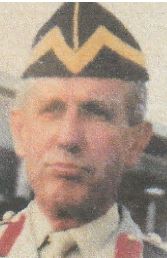You could hear Rodney from afar. It was the laugh; there was no other like it – a cross between a horse’s snort and a friendly but raucous cackle delivered at full volume.

There were those among his contemporaries who put down their later deafness not to the roar of the Chieftain tank’s gun but to Martin’s laugh.
From Mons Officer Cadet School, in 1955 he joined the 4th Hussars in Hohne, West Germany, together with his terrier Drum, an irascible piece of canine devilry from whom his owner was seldom separated. Posted to ‘C’ Squadron he soon distinguished himself as a horseman to be reckoned with, winning prizes on the racecourse as well as in the show-jumping ring.
Shortly after his Regiment’s amalgamation with the 8th Hussars, its near neighbour at Lüneburg, he was sent on a gunnery course and, as his squadron’s gunnery officer, was instrumental in its becoming the first Duke of Edinburgh’s Squadron.
In the Queen’s Royal Irish Hussars, he continued as a troop leader until promoted during the Regiment’s tour of Aden in 1961 where he served in the detached squadron in Sharjah and in both Aden itself and the West Aden protectorate. The Regiment’s move to Malaya and Singapore in October of the following year was expected to be both peaceful and enjoyable, giving plenty of opportunities for sport, travel and entertainment.
Circumstances, however, dictated otherwise: the creation of Malaysia which at its inception included Singapore and both British colonies on the island of Borneo, Sarawak and Sabah, triggered a rebellion in Brunei, a British protectorate and brought forth threatening noises from Indonesia which incorporated most of the island of Borneo, and signs of a possible Chinese communist uprising in Sarawak.
Troops from ‘B’ Squadron went to Brunei’s aid and in January 1963 ‘C’ Squadron was deployed to Kuching in Sarawak.
Lieutenant Colonel John Strawson, the commanding officer designate, was appointed to command a force which included ‘C’ Squadron, a Gunner battery and a battalion of Sarawak Rangers. He chose Rodney to be his operations officer. In this role he performed with his usual good humour and efficiency until Indonesian incursions grew exponentially frequent, causing an influx of British and Gurkha infantry battalions and a Royal Marines commando.
Strawson and Martin left Sarawak, Strawson to command the Regiment and Martin to England to join a team of lecturers and, more importantly, to persuade Gale McArthur to marry him.
Rodney had two brothers whose wives were known as Birdie and Feather so it was inevitable that the new Mrs Martin should also acquire an avian pet name. Galeybird she became and Galeybird she has been ever since.
He came back to the Regiment in Wolfenbüttel as adjutant, first to Strawson and then to John Paley whose forte was not regimental administration, a burden that Rodney assumed in a quietly (except for the laugh) effective way.
Next, he spent three years at Sandhurst casting a stern eye over would-be Irish Hussars before returning to the Regiment at Paderborn to command ‘C’ Squadron. There he resumed his interest in regimental equine affairs, running a racing stable and, although not playing much polo himself, generously made his ponies available to others.
He became second-in-command for two years before being selected to command the Queen’s Own Yeomanry. He was sadly disappointed not to have command of the Irish Hussars but in typical Martin fashion, threw himself wholeheartedly into his new regiment. His yeomen – officers and soldiers – loved him and he forged many enduring friendships which led the Martins to settle in Northumberland.
But not immediately as after command he was first posted to the multi-national peacekeeping force in Sinai and then spent some time at the German Higher Staff college followed by a tour as the British Liaison Officer to the German Armour School before returning to England, first to the Ministry of Defence and then to command the RAC Gunnery School at Lulworth from where he moved on to be deputy commander of the RAC Centre.
His final posting was to Zimbabwe as military attaché which enabled him and Galeybird to entertain a series of Irish Hussars as they took up temporary training posts in that country.
After retirement, he hunted, fished, and went racing (he was an owner for a while) from his house near the River Tweed and interested himself in 4th Hussar benevolence matters and in organising that regiment’s luncheon club.
Rodney Martin was the very model of a cavalry officer of his time. Flamboyant and carefree on the surface he cared deeply about the welfare of those over whom he was appointed to command and he always put their interests and the interests of his regiment first. He loved soldiering and believed that, above almost all things it should be fun.


